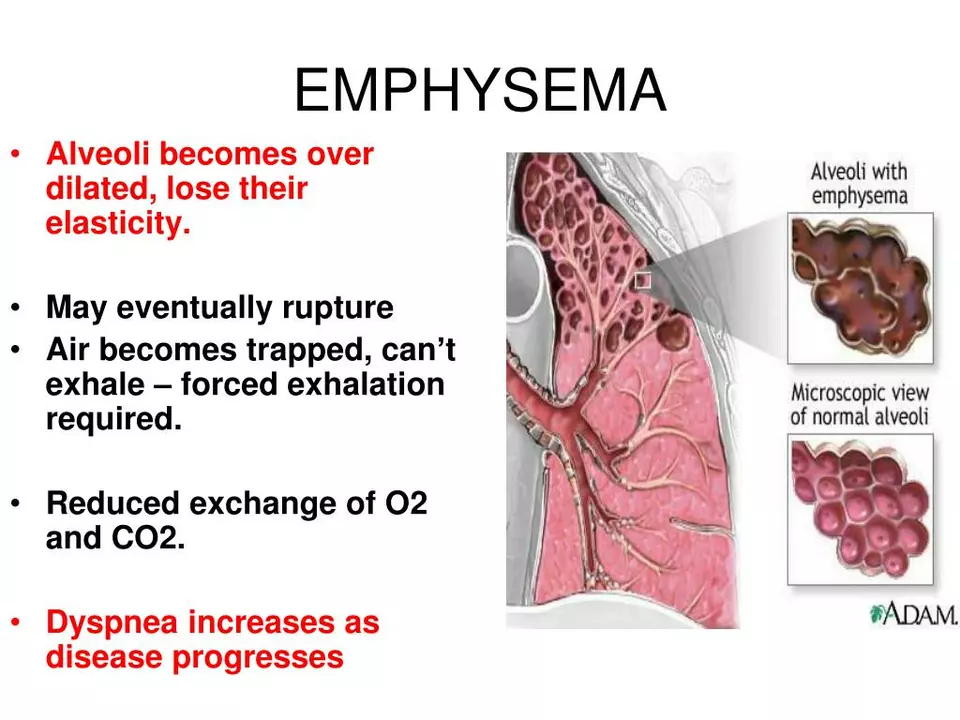Emphysema: What You Need to Know Right Now
If you or someone you love has been told they have emphysema, the first reaction is often “what does that even mean?” Put simply, emphysema is a lung disease where the air‑sacs (alveoli) get damaged and lose their elasticity. That makes it harder for oxygen to move into your blood and for carbon dioxide to leave.
The condition usually creeps in over years, especially if you’ve smoked or been exposed to lots of dust or chemicals. You might notice a persistent cough, shortness of breath during simple tasks, or a feeling that you can’t get enough air even when you’re resting. Those are the classic red flags, and catching them early helps you stay ahead of the disease.
What is Emphysema?
Think of your lungs as tiny balloons. In healthy lungs, each balloon stretches and snaps back easily with every breath. Emphysema turns those balloons into floppy, stretched‑out sacs that don’t recoil well. The walls break down, the surface area shrinks, and you end up with less room for oxygen.
The main culprits are long‑term smoking, second‑hand smoke, air pollution, and genetic factors like alpha‑1 antitrypsin deficiency. Even if you’ve quit smoking years ago, the damage can keep progressing, which is why regular check‑ups matter.
Doctors confirm emphysema with a spirometry test – it measures how much air you can blow out forcefully and how fast. If your FEV1 (the amount of air exhaled in one second) is low, that’s a clear sign the lungs are compromised.
Managing Emphysema Daily
The good news is there are practical steps you can take right now to ease breathlessness and slow down further damage. Start with medication: bronchodilators (inhalers) relax airway muscles, making it easier for air to flow. Steroid inhalers reduce inflammation if flare‑ups happen often.
Pulmonary rehabilitation is a game‑changer. It’s a mix of guided exercise, breathing techniques, and education. Simple routines like diaphragmatic breathing or pursed‑lip breathing help you control the airflow and keep your oxygen levels steady during everyday tasks.Staying active matters more than you think. Light activities—walking, swimming, cycling on a stationary bike—boost lung capacity without overexertion. Aim for short sessions several times a day rather than one long workout.
Nutrition also plays a role. A balanced diet rich in fruits, vegetables, lean protein, and whole grains supplies the energy you need to breathe easier. Avoid heavy meals that can push up on your diaphragm and make breathing feel tighter.
Don’t forget vaccinations. Flu shots and pneumonia vaccines protect you from infections that can trigger severe exacerbations. If you notice a sudden increase in coughing, wheezing, or fever, call your doctor promptly – early treatment prevents hospital stays.
Finally, create a smoke‑free environment at home. Use air purifiers if possible, keep windows open for fresh air, and steer clear of strong scents from cleaning products or perfumes that can irritate the lungs.
Living with emphysema isn’t about giving up; it’s about adapting smartly. By understanding what’s happening inside your lungs, using the right meds, staying active, and keeping a clean air space, you can keep breathing easier and enjoy daily life much more fully.
Emphysema can be a challenging condition to live with, but I've found several strategies to help cope with it in my daily life. First, I focus on maintaining a healthy lifestyle by eating well, exercising, and staying up-to-date with vaccinations. I've also learned the importance of managing stress and practicing relaxation techniques to help with shortness of breath. Additionally, I make sure to take my medications as prescribed and stay in close contact with my healthcare team. Lastly, joining a support group has been very helpful in connecting with others who understand what I'm going through.

